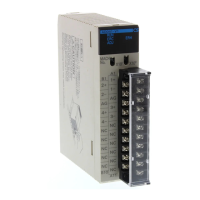54
or the three blocks can be coded first followed by two OR LOADs. The mne-
monic codes for both methods are shown below.
00000 LD 00000
00001 AND NOT 00001
00002 LD NOT 00002
00003 AND NOT 00003
00004 OR LD —
00005 LD 00004
00006 AND 00005
00007 OR LD —
00008 OUT 00501
00000 LD 00000
00001 AND NOT 00001
00002 LD NOT 00002
00003 AND NOT 00003
00004 LD 00004
00005 AND 00005
00006 OR LD —
00007 OR LD —
00008 OUT 00501
Address Instruction Operands Address Instruction Operands
Again, with the method on the right, a maximum of eight blocks can be com-
bined. There is no limit to the number of blocks that can be combined with
the first method.
Both of the coding methods described above can also be used when using
AND LOAD and OR LOAD, as long as the number of blocks being combined
does not exceed eight.
The following diagram contains only two logic blocks as shown. It is not nec-
essary to further separate block b components, because it can be coded di-
rectly using only AND and OR.
00000 00001 00002 00003
00201
00501
00004
Block
a
Block
b
Address Instruction Operands
00000 LD 00000
00001 AND NOT 00001
00002 LD 00002
00003 AND 00003
00004 OR 00201
00005 OR 00004
00006 AND LD —
00007 OUT 00501
Although the following diagram is similar to the one above, block b in the dia-
gram below cannot be coded without separating it into two blocks combined
with OR LOAD. In this example, the three blocks have been coded first and
then OR LOAD has been used to combine the last two blocks, followed by
AND LOAD to combine the execution condition produced by the OR LOAD
with the execution condition of block a.
When coding the logic block instructions together at the end of the logic
blocks they are combining, they must, as shown below, be coded in reverse
order, i.e., the logic block instruction for the last two blocks is coded first, fol-
Combining AND LOAD and
OR LOAD
Basic Ladder Diagrams Section 4-3

